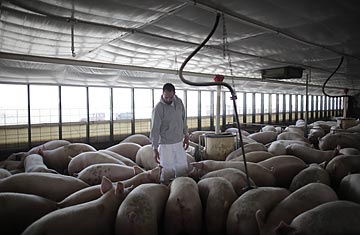
Although the first wave of the H1N1 outbreak emerged in Mexico, the CDC made the first official diagnosis in a child in San Diego on April 14. Genetic analysis indicates the virus has been circulating in the human population since last September and it's entirely possible, given the close connection between the U.S. and Mexico, that H1N1 could have first infected people in the U.S. and then been carried south across the border. (See pictures of swine flu hitting Mexico.)
But where the disease first surfaced is less relevant than the conditions that created it. A study by the Pew Charitable Trusts and the Johns Hopkins Bloomberg School of Public Health found that dense factory farms could increase the risk for the spread of new viruses, including the flu. And in the case of H1N1, the farming of domestic animals, like pigs and poultry, could have bred the virus. But officials have yet to locate "pig zero," having failed to find the virus among any pigs — except in swine in Alberta, Canada, which were infected by human workers.
It's too late to put H1N1 back in its bottle, but better surveillance of factory farms and the international animal trade, which can spread emerging diseases across borders, might help prevent the next flu. "It's not the fault of the pigs," says Peter Daszak, the president of the Wildlife Trust. "We have to blame ourselves."